BP Says Gulf Cleanup Over
Air Date: Week of April 25, 2014
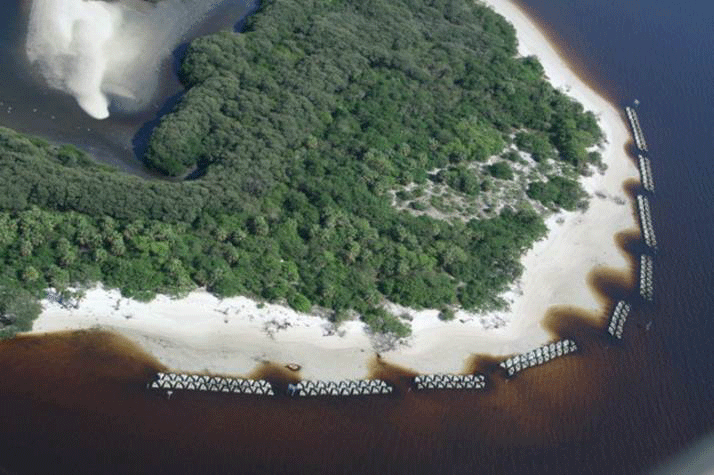
Breakwater construction projects are a tool for restoration of Alafia Banks, an Audubon sanctuary hosting 18 species of colonially-nesting waterbirds and seabirds in Tampa’s Hillsborough Bay. Restoration will reduce erosion, increase available nesting habitat, and improve water quality on a globally Important Bird Area. (Photos: National Audubon Society/ Audubon Florida)
Oil from the Deepwater Horizon disaster still washes up on beaches after storms, but BP recently announced that their active cleanup phase has come to an end. But Audubon bird specialist Melanie Driscoll tells host Steve Curwood that oil keeps coming ashore and we’re only beginning to understand the impact of the spill on the gulf ecosystem.
Transcript
CURWOOD: During April - Earth Month - we revisit some past stories to find out what developments there have been. On April 20, 2010, BP’s Deepwater Horizon well exploded, killing 11 workers, and eventually gushing over 200 million gallons of oil into the Gulf of Mexico. Soon after the blow-out, a Sky News reporter asked BP’s CEO Tony Hayward what effect he thought the oil would have on the Gulf of Mexico.
HAYWARD: I think the environmental impact of this disaster is likely to have been very, very modest. It is impossible to say and we will mount, as part of the aftermath, a very detailed environmental assessment but everything we can see at the moment suggests that the overall environmental impact of this will be very, very modest.
CURWOOD: Well, many researchers along the Gulf coast did not believe Mr. Hayward was right.
And back in 2010, Living on Earth’s Jeff Young visited the coast of southern Louisiana to check out the reality.
[SOUNDS OF SURF]
YOUNG: Grand Isle is about as far south as you can get in Louisiana by land—or what’s left of the land, anyway. Erosion and subsidence have melted miles of the surrounding marsh into open water. But this is still crucial bird habitat and an important time for birds—breeding season.
DRISCOLL: There are least terns mating. That would be normal breeding season behavior.
YOUNG: Melanie Driscoll has binoculars pressed to her eyes—as she often does. She directs Audubon’s Louisiana program.
DRISCOLL: They’re just toward the edge of the water, it’s a very quick event—it’s over already.
YOUNG: They’re not big on afterglow, are they?
DRISCOLL: [LAUGHS] Bird copulation is a fairly short-lived event without a lot of ceremony, usually.
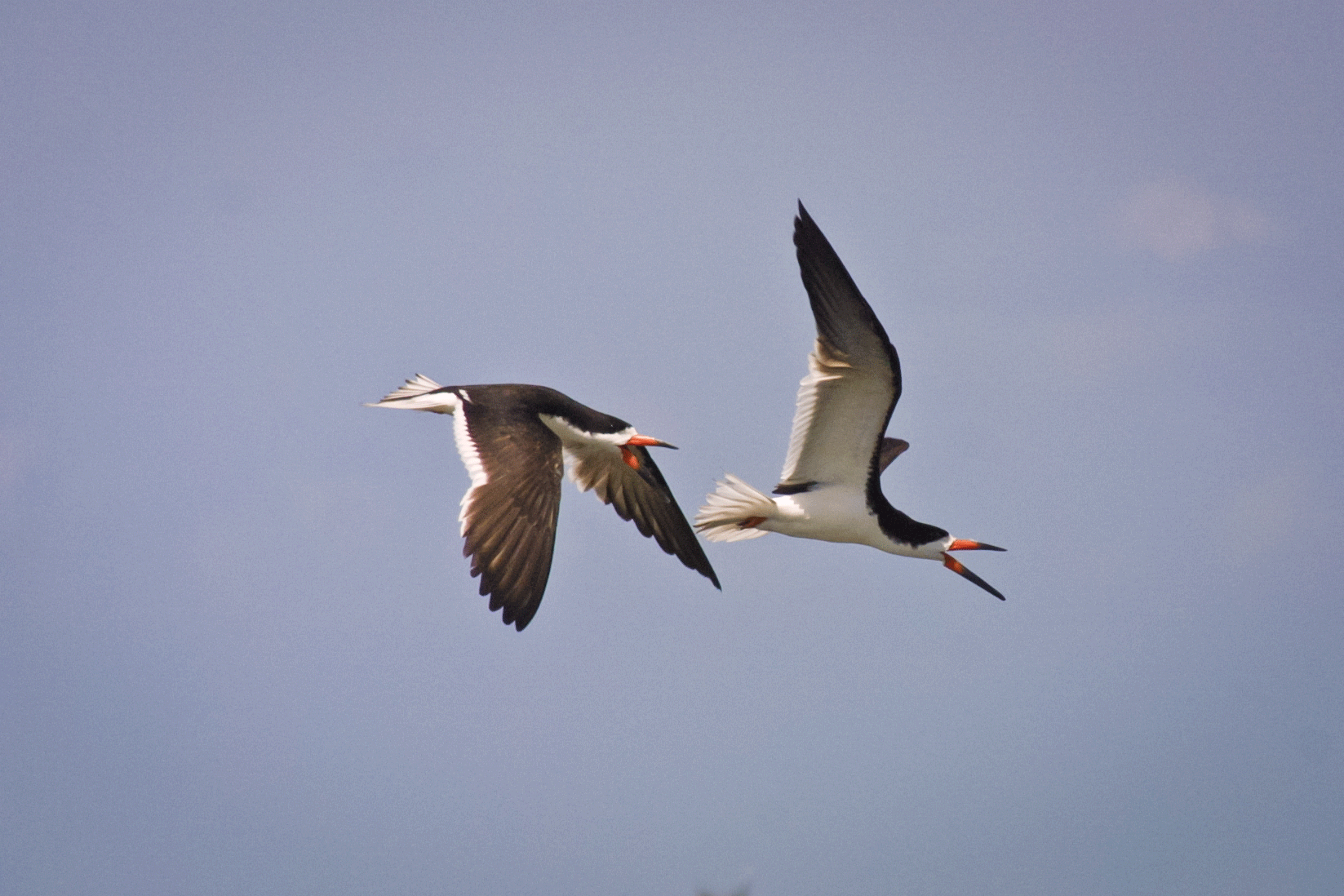
Black Skimmers chasing during courtship, Raccoon Island, LA (photo: National Audubon Society/Melanie Driscoll)
YOUNG: The male tern flies back to his mate with a gift—a small fish. In a normal year this would be a happy time and a happy scene for Driscoll, watching resident species take to the nests and thousands of migrants pass through. But this is not a normal year. The long line of bright orange oil booms just offshore reminds us. The dozen or so oil platforms on the horizon remind us. And everything about the terns’ little love scene here now seems loaded with danger—is the oil in the water here? Is it in that fish he just caught?
DRISCOLL: They don’t get any warning. They eat the food, they drink water of the Gulf and they are driven to breed where they’ve bred before, whether that habitat is disturbed or not just affects their success, not their drive to breed here.
YOUNG: There are globally important bird areas in these marshes and barrier islands. And some are now taking oil. Driscoll is here to keep tabs on what is likely to be a grim toll. The oil is slowly taking effect just as many birds are most vulnerable. She takes meticulous notes on the sanderlings, turnstones, redknots, brown pelicans. The point is not just to look for oiled or dead birds, but to detect the absence of birds.
DRISCOLL: Because birds will die undiscovered we are less reliant on a body count in this spill because it is so different than eventually a change in abundance, a change in numbers.
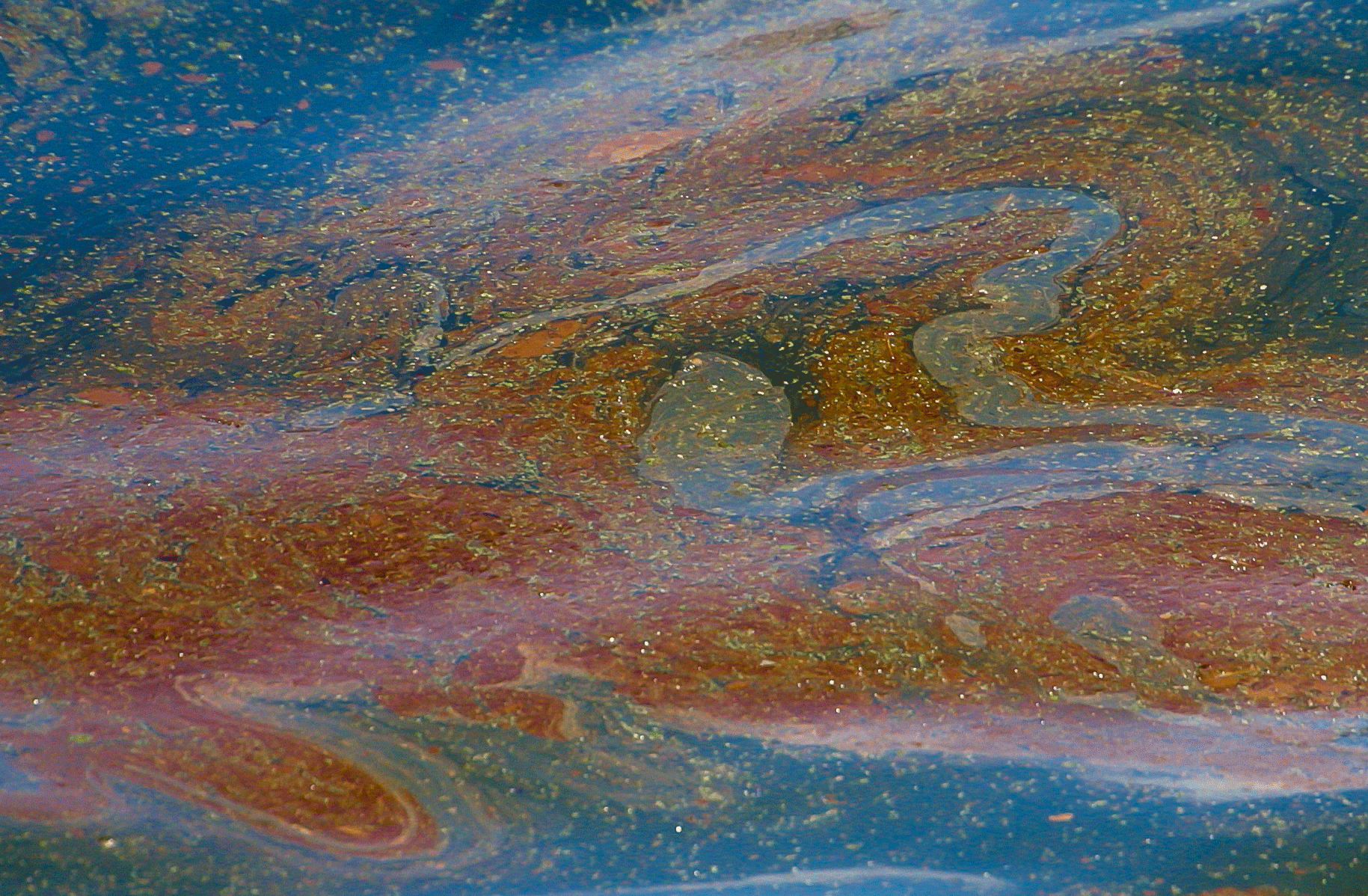
Oil on water after the BP spill from 2010 (photo: National Audubon Society/Melanie Driscoll)
YOUNG: So you might not know what’s really going on here until next year?
DRISCOLL: We likely won’t know for a year for some species. Others species, many birds, of northern gannets, particularly young, stay out in Gulf for a couple of years until they reach breeding maturity. If those birds are dying it may be three or four years before we notice a change in the nesting population.
YOUNG: It’s so complicated the interaction of things here. As a layperson your impression is well, is there oil on the bird? No? Well, okay! But there’s a lot more to it than that.
DRISCOLL: There’s a saying about ecology that it’s not rocket science, it’s a lot more complicated than that. We’re looking at a system. The birds rely, not just on their feathers insulating them, they rely on food chains that are underwater or in the sand, they rely on protection from predators by being familiar with their surroundings—it’s very complicated.
YOUNG: And it gets more complicated. Several fish stocks in the Gulf were already in serious decline. The mouth of the Mississippi already sees a massive dead zone of low oxygen each year. The land is already slipping into the sea. And now comes the oil. Driscoll wonders how much the ecosystem can take.
DRISCOLL We don’t know. We’re playing roulette with these Louisiana marshes. They’re under many, many threats. They’re in a working landscape and that puts them at more risk for oil and gas spills. We don’t know. This fragile systems are very productive. There’s a threshold; you might have increased productivity before a crash. We’re afraid of the crash. We don’t know what will be the tipping point. The oil makes that tipping point probably closer.
YOUNG: Driscoll and other scientists and conservationists in the region are settling in for a long haul effort. Stopping the gushing oil in the Gulf may be a race, but understanding the ecological impact is a marathon.
[SOUNDS OF SURF]
CURWOOD: Well, four years later, BP has announced that it’s ending the “active cleanup” from the spill, even though US Coast Guard officials argue that the job’s not finished. And to find out how the birds in the Gulf are faring today, we called up Audubon’s Melanie Driscoll again. She says oil is still washing up on the Louisiana's beaches.
DRISCOLL: Where the oil was heaviest we still see it fairly frequently, places like Grand Isle where we spoke four years ago, it occurs after summer storms, hurricanes and other high tides.
Sometimes that's little tar balls, but last June a 40,000 pound mat of tar rolled up onto East Grande Terre Louisiana. There are hundreds, thousands of pounds of oil left in the system, and some of those will continue to come up onto our beaches.
CURWOOD: What is the state of the Gulf of Mexico today? How is the ecosystem doing?
DRISCOLL: We know from some of the science done since the oil spill that there are some ecological effects from the spill. We know that some deepwater corals near the spill site have been killed. We’ve seen things like oil accumulated in the tissues of eggs in birds like the American White Pelican and the Common Loon, and that shorebirds have been less successful foraging in areas where the cleanup activities caused continued disturbance. We expect that there will be studies eventually that show that hundreds of thousands of birds were killed during the acute phase of the disaster, but the challenge is that, at this time, the studies are tied up in the natural resources damage assessment. What scientists know is held within that legal process to prosecute the responsible parties, and so the government can’t talk about what’s really going on with the Gulf ecosystem, and independent conservation organizations can’t appropriately help guide responses because a lot of the studies are not available at this time. From other spills, we know that acute toxicity mutations, egg failure, reduced nestling growth, reduced reproduction and survival can plague birds in spill impact areas, and this was a very big spill impact area.
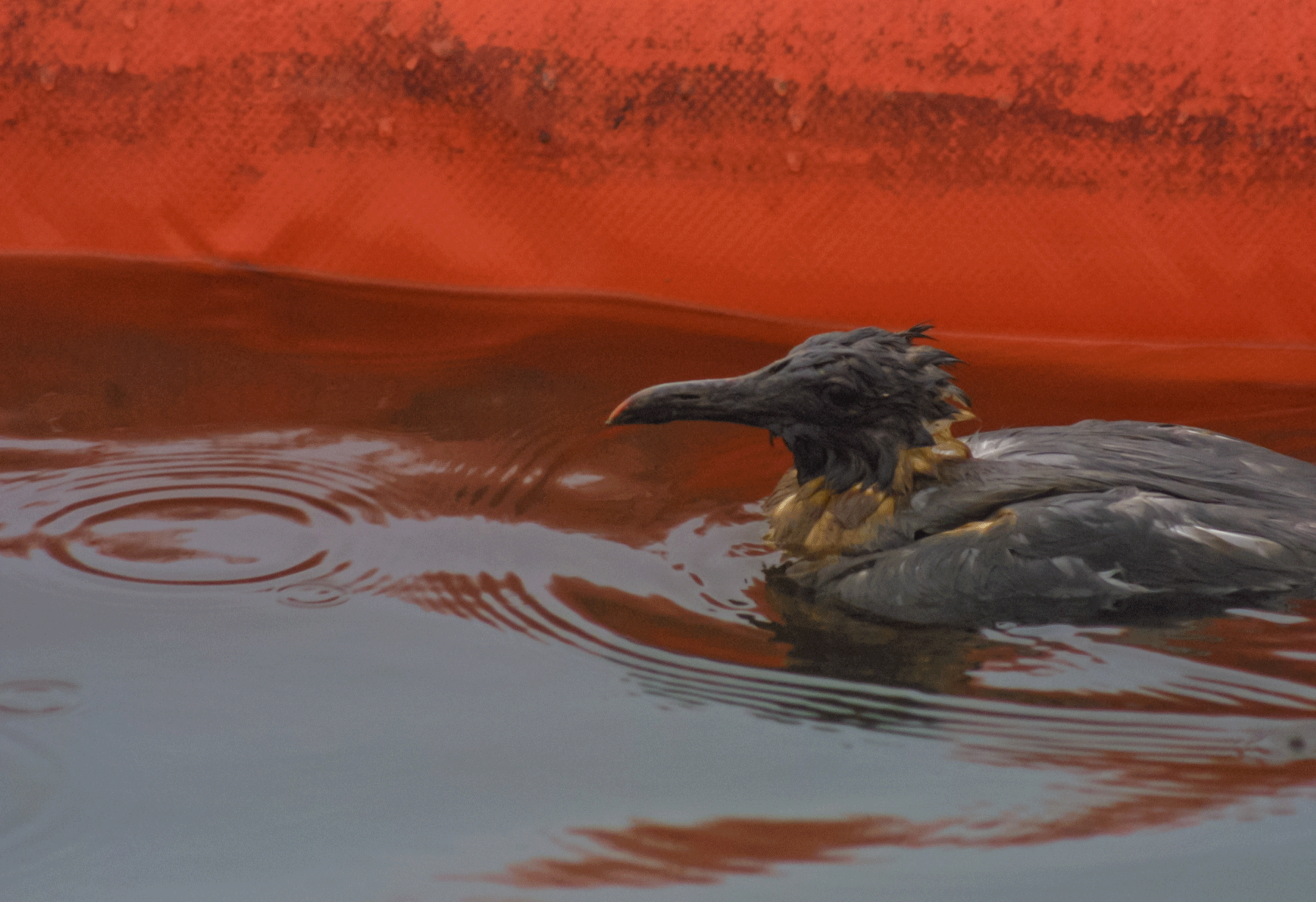
Oiled Laughing Gull, Barataria Bay, LA. Bird was eventually rescued, rehabilitated, and released (photo: National Audubon Society/Melanie Driscoll)
CURWOOD: Back when you spoke to Jeff Young, you said that we wouldn’t know the impact of the spill on bird populations for a few years. We’re four years on. Overall, how are the birds doing?
DRISCOLL: It’s a little difficult to say. We go out to nesting islands, and we see a couple of different things. Out in Barataria Bay and Bay Jimmy where the oil came in very heavily, some of the islands like Queen Bess have what seem to be thriving populations of pelicans and Roseate Spoonbills, terns and egrets. Other islands where the birds were nesting during that fateful summer of 2010, the islands are completely gone or they are so small that there’s no room for birds to nest. And if they dared to try, their nests would be over-washed in the first summer storm. So those birds had to go somewhere, and, we don’t have really good tracking available to know where those birds have gone or if they’re breeding successfully somewhere else.
CURWOOD: What happened to the islands. Why did they go away?
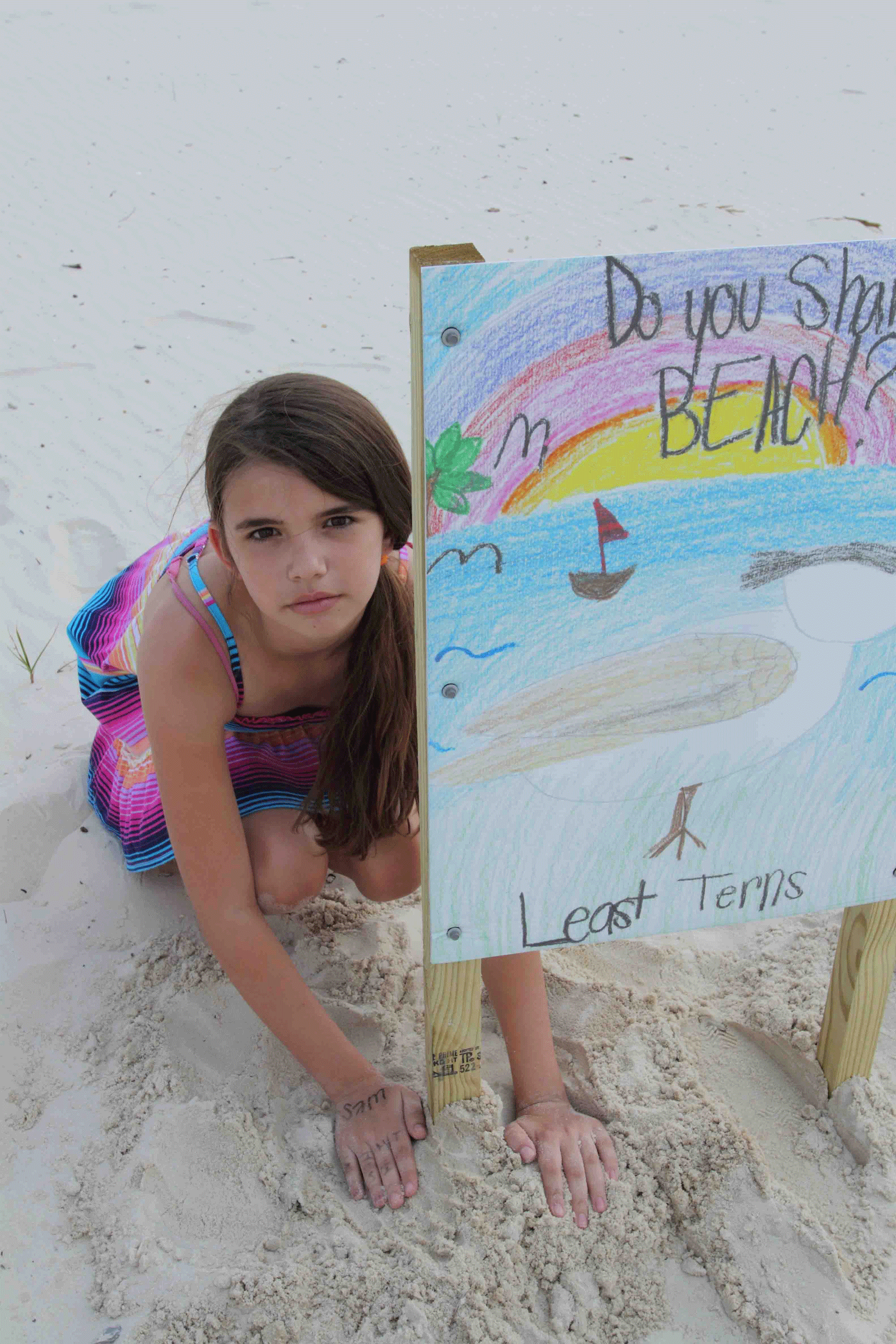
Schoolgirl in Mississippi helping install sign she created to encourage beachgoers to share the beach with nesting Least Terns. An effective and tested strategy to reduce disturbance, engage communities, increase nesting success and improve populations of birds harmed during the DWH disaster. (Photo: National Audubon Society/Mozart Dedeaux)
DRISCOLL: The islands were in a bay in which they were already eroding, and they were eroding fairly quickly, but some of those islands were covered with thick lush mangroves that were the nesting sites for the Brown pelicans. Oil, when it heavily coats marsh grass or mangroves, can suffocate the roots, and the root systems are really what holds this sediment together. They hold the sand in place and allow there to be land out there in the middle of the Gulf. The mangroves are dead. It actually looks like a little miniature tree graveyard out on one of the sites. It’s just stark brown branches where thriving green mangroves coated an island. As the roots have died, the erosion has either increased or continued and there’s virtually nothing left now. This is again the challenge in that all of the science being done or most of it is held within a confidential process. All I can say is I’ve never seen mangroves die this quickly and the erosion seems to be very high. I can’t say that’s attributable to the spill. It’s just very suspicious that this would be happening at that rate.
CURWOOD: So it’s almost a quarter century ago that the Exxon Valdez spill occurred, and it’s still impacting the ecosystem there in Prince William Sound in Alaska. How long before we will really know the scope of the damage that was gone to the Gulf of Mexico by the Deepwater Horizon Disaster?
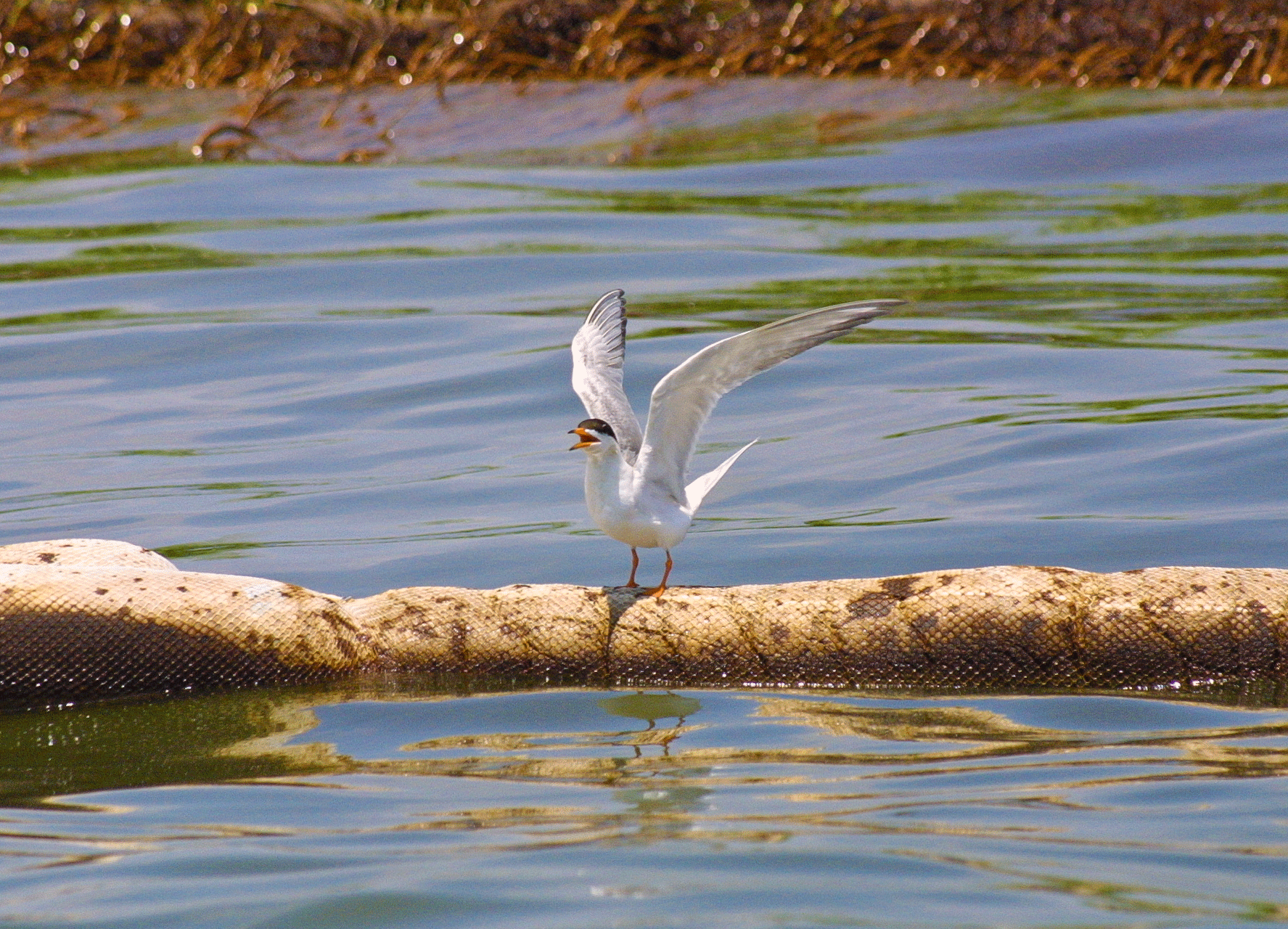
Forster’s Tern perched on oiled boom, with oiled marsh in background in 2010 (photo: National Audubon Society/Melanie Driscoll)
DRISCOLL: Like with the Exxon Valdez, I think we’ll know parts of it in the next few years, but it will be decades until we know the full toll. The Pigeon Guillemot is the bird species that has struggled the most to recover from the Exxon Valdez spill. Many thousands died in Prince William Sound during the disaster, and since then they have faced problems both in the food that the adults eat, and in the Pigeon Guillemot becoming a favored prey of mink and river otter, when the shellfish prey of the mink and river otter was compromised by the spill. Because of the increase of a variety of threats, the Pigeon Guillemot population in the Prince William Sound has never recovered.
As Also Leopold stated, “To keep every cog and wheel is the first precaution of intelligent tinkering.” We, as humans, are really not wise enough to randomly tug at strands in the web of life, and then to predict which tug should cause a link to break. It puts us in the position now of needing to study, to monitor, to steward, and restore and to hope that in doing so we’re able to support the populations damaged by this spill even if we can’t say yet which of those populations are most critically damaged.
CURWOOD: Melanie Driscoll is the Director of Bird Conservation for the Gulf of Mexico and the Mississippi Flyaway for the National Audubon Society. Thanks for taking the time with us today, Melanie.
DRISCOLL: Thank you, Steve, it’s been a pleasure to be here.
Links
Living on Earth wants to hear from you!
Living on Earth
62 Calef Highway, Suite 212
Lee, NH 03861
Telephone: 617-287-4121
E-mail: comments@loe.org
Newsletter [Click here]
Donate to Living on Earth!
Living on Earth is an independent media program and relies entirely on contributions from listeners and institutions supporting public service. Please donate now to preserve an independent environmental voice.
NewsletterLiving on Earth offers a weekly delivery of the show's rundown to your mailbox. Sign up for our newsletter today!
 Sailors For The Sea: Be the change you want to sea.
Sailors For The Sea: Be the change you want to sea.
 The Grantham Foundation for the Protection of the Environment: Committed to protecting and improving the health of the global environment.
The Grantham Foundation for the Protection of the Environment: Committed to protecting and improving the health of the global environment.
 Contribute to Living on Earth and receive, as our gift to you, an archival print of one of Mark Seth Lender's extraordinary wildlife photographs. Follow the link to see Mark's current collection of photographs.
Contribute to Living on Earth and receive, as our gift to you, an archival print of one of Mark Seth Lender's extraordinary wildlife photographs. Follow the link to see Mark's current collection of photographs.
 Buy a signed copy of Mark Seth Lender's book Smeagull the Seagull & support Living on Earth
Buy a signed copy of Mark Seth Lender's book Smeagull the Seagull & support Living on Earth

